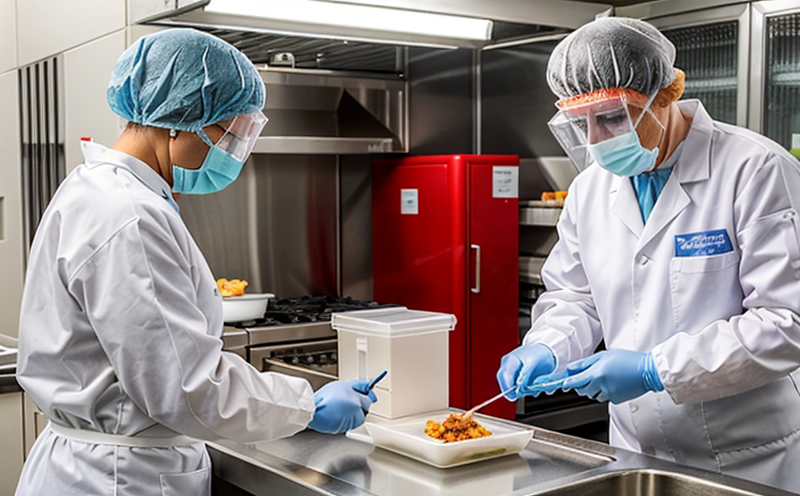EN 17429 Detection of Norovirus in Frozen Berries Using RT-qPCR
The European Standard EN 17429: Microbiology of food and feed - Determination of noroviruses by reverse transcription quantitative polymerase chain reaction (RT-qPCR) provides a standardized method for detecting the presence of noroviruses in food products, particularly frozen berries. Norovirus is a significant public health concern as it can cause acute gastroenteritis outbreaks through contaminated food and water.
Frozen berries are a popular choice among consumers due to their year-round availability and nutritional value. However, they carry the risk of contamination with noroviruses if not handled or processed properly during cultivation, harvesting, or freezing processes. This service ensures that frozen berry products meet stringent safety standards, thereby protecting public health.
The reverse transcription-qPCR (RT-qPCR) method used in this testing protocol is highly sensitive and specific for detecting norovirus RNA. The process begins with the collection of samples from the frozen berries, followed by extraction of viral nucleic acids using appropriate methods such as bead-beating or commercial kits. RT-qPCR amplification is then performed under controlled conditions to quantify the target virus.
Quality managers and compliance officers will benefit greatly from this service as it aligns with regulatory requirements set forth in EN 17429. By adhering to these standards, food manufacturers can ensure their products are safe for consumption. R&D engineers involved in developing new frozen berry products must also consider norovirus contamination risks during the design phase.
The application of this method extends beyond mere compliance; it contributes significantly to maintaining consumer confidence and trust in food safety practices. For procurement teams responsible for sourcing high-quality raw materials, ensuring suppliers meet these stringent testing protocols can help mitigate potential health hazards associated with norovirus exposure.
- Improved Product Safety: By implementing this test procedure, frozen berry producers demonstrate their commitment to producing safe and wholesome products.
- Increased Consumer Trust: Meeting or exceeding regulatory standards enhances brand reputation among discerning consumers who prioritize food safety.
- Compliance with Regulations: Ensuring adherence to international guidelines like EN 17429 helps avoid legal issues and sanctions from authorities.
- Potential Market Expansion: Demonstrating robust quality control measures can open up new markets for frozen berry products globally.
In conclusion, the EN 17429 method offers a reliable means of detecting norovirus in frozen berries. Its implementation not only satisfies regulatory demands but also plays a crucial role in safeguarding public health and fostering consumer trust.
Applied Standards
The EN 17429 standard specifies the procedure for determining noroviruses using reverse transcription quantitative polymerase chain reaction (RT-qPCR). This method is widely accepted in Europe and internationally due to its precision and reliability. Compliance with this standard ensures that laboratories adhering to it deliver accurate results consistently.
The protocol outlined in EN 17429 includes several key steps: sample preparation, RNA extraction, reverse transcription, qPCR amplification, and data analysis. Each step is meticulously designed to minimize contamination risks while maximizing detection sensitivity. The standard also provides detailed instructions on reagents, equipment, and laboratory practices necessary for successful execution of the assay.
This document has been developed by experts in virology and food safety science who have extensive experience working with noroviruses and related technologies. Their expertise ensures that EN 17429 remains up-to-date with advances in molecular diagnostics while maintaining compatibility with existing regulatory frameworks.
Adhering to these standards not only enhances the credibility of test results but also facilitates international trade by ensuring consistency across different jurisdictions. Laboratories accredited according to ISO/IEC 17025 can further enhance their reputation by offering services based on internationally recognized protocols like EN 17429.
In summary, compliance with the EN 17429 standard is essential for any laboratory seeking to provide reliable norovirus detection in frozen berries. By following this protocol rigorously, laboratories ensure that their results are accurate, reproducible, and meet regulatory expectations.
International Acceptance and Recognition
The EN 17429 method is widely recognized not only within Europe but also internationally for its robustness and reliability. Many countries have adopted this standard as part of their national food safety regulations, acknowledging its value in ensuring public health.
One notable aspect of EN 17429's success lies in its collaborative development process involving scientists from multiple disciplines and regions. This global collaboration ensures that the method remains relevant to diverse environments and challenges faced by food producers worldwide.
The widespread adoption of this standard contributes significantly to international trade in frozen berries, as it establishes a common language for detecting norovirus contamination. Laboratories accredited under EN 17429 are thus able to serve markets across continents with consistent quality and accuracy.
In addition to its technical merits, the EN 17429 method has garnered significant recognition from regulatory bodies around the world, including those in North America and Asia. This global acceptance underscores its importance as a tool for maintaining high standards of food safety globally.
The future outlook for EN 17429 looks promising, with ongoing efforts to refine and expand upon this method. As new challenges arise in the field of food safety, it is likely that this standard will continue to play a vital role in addressing them effectively.





